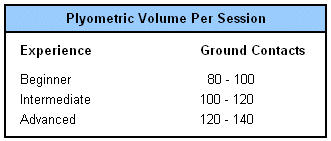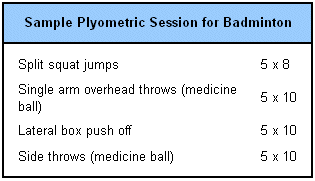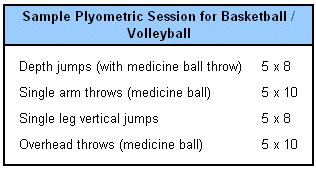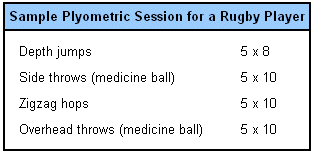Plyometric training has been shown to be one of the most effective methods for improving explosive power. A wide variety of athletes can benefit from power training, particularly if it follows or coincides with a strength training program.
This article outlines how to set up a plyometric program covering the parameters for sets, repetitions and exercise selection. The guidelines on this page can be used in conjunction with the various animated lower body plyometric exercises and upper body plyometric drills in this section of the website.
If you are interested in how plyometric training works and the physiology behind it, see the the physiology of plyometrics article.
Plyometrics & The Strength Training Program
In order for plyometric training to be at its most effective it should follow a phase of maximal strength training. The purpose of plyometrics is to improve the athletes capacity to applymore force more rapidly. Logically then, the greater the athletes ability to generate maximal force or strength to begin with, the more of it can be converted into sport-specific power. See the sport specific approach to strength training programs for the big picture and how plyometrics fits in to the overall strength program.
Plyometric Exercise Selection
There are many plyometric exercises for both the upper and lower body. As with other forms of sports training, exercise selection should mimic the movement patterns of the sport as closely as possible.
Lower Body Plyometric Exercises
lower body plyometric exercises are suitable for many sports such as basketball, track & filed athletics, sprinting, soccer, hockey, rugby, football, baseball and so on. In fact, performance in any sport that involves jumping, sprinting or kicking can be improved with lower body plyometric exercises.
lower body plyometric exercises are suitable for many sports such as basketball, track & filed athletics, sprinting, soccer, hockey, rugby, football, baseball and so on. In fact, performance in any sport that involves jumping, sprinting or kicking can be improved with lower body plyometric exercises.
Upper Body Plyometric Drills
Performance in sports such as basketball, volleyball, softball, baseball, tennis, badminton, golf and the throwing events in athletics can benefit with upper body plyometric exercises. Also, certain position players such as goal keepers in soccer will find these drills useful. Most upper body plyometric drills requires the use of a medicine ball.
Performance in sports such as basketball, volleyball, softball, baseball, tennis, badminton, golf and the throwing events in athletics can benefit with upper body plyometric exercises. Also, certain position players such as goal keepers in soccer will find these drills useful. Most upper body plyometric drills requires the use of a medicine ball.
Exercise Intensity
The intensity of plyometric exercises varies greatly. Skipping exercises are classed as low intensity, while reactive drop jumps from 32in (80cm) and above are the highest intensity of the plyometric exercises. See the table below for further intensity classifications:

Plyometric training should progress gradually from lower intensity to higher intensity drills, especially for individuals who lack a significant strength training background.
Increasing the load by adding additional weight thought weighted vests of ankle weights for example, is not recommended. Too great a load can reduce the speed and quality of movement negating the effects of plyometrics.
Volume
Plyometric volume relates to the number of repetitions per session. For lower body exercises a repetition is a ground contact. See the table below for the number of repetitions recommended for a plyometric training session:

Frequency
Typically, 2-3 sessions of plyometrics can be completed in a week. Alternatively, recovery time between sessions can be used to prescribe frequency and is recommended at 48-72 hours .
It is not recommended that plyometric training be scheduled for the day after a heavy weight training session when muscles may still be sore. This poses a planning problem for athletes that may need to strength train 3-4 times per week. The table below offers a solution to this problem by alternating upper and lower body strength training with upper and lower body plyometrics:

The phase of the training program will also determine how many plyometric training sessions are suitable per week. For example, a track and filed athlete may require 3-4 sessions during the preparation phase reducing to 2-3 session in-season. A football player on the other hand may require only 2-3 sessions pre-season reducing to 1-2 sessions during the competitive season.
Rest Intervals
The effectiveness of a plyometric training session depends on maximal effort and a high speed of movement for each repetition. Rest intervals between repetitions and sets should be long enough to allow almost complete recovery. As much as 5-10 seconds may be required between depth jumps and a work to rest ratio of 1:10 is recommended. For example, if a set of bounds takes 30 seconds to complete, the rest interval between sets would be 300 seconds or 5 minutes.
Warming Up
As with any training an adequate warm up is required before completing a plyometric training session. The Nation Strength & Conditioning Association recommends that toe jogging and straight leg jogging be included as part of the warm up to prepare for the shock impact of plyometric drills. Plyometrics should be completed at the start of a combined session when the athlete is fresh.
Safety Considerations
Limited data exists as to whether there is any increased risk of injury through plyometric training. However, due to the stress that repeated shock-tension exercises can place on joints and connective tissue, several safety guidelines have been proposed.
It has been suggested that athletes should be able to complete a one repetition maximum squat a weight 1.5 times that of their bodyweight and bench press a weight 1-1.5 times bodyweight.
Balance is also an important factor in the safe performance of plyometric exercises. Again, it has been recommended that athletes can stand on one leg for 30 seconds in order to complete less intense exercises. For more advanced exercises they should be able to stand on one leg for 30 seconds in a semi-squat position.
Plyometric training is contraindicated in prepubescent children as it may cause damage to the epithyseal plates that have yet to close (7,9). Some strength and conditioning professionals have questioned this as children routinely perform jumping movements as part of unstructured play. However, to be effective, plyometric training requires numerous, repeated maximal efforts. It is the structured nature of training that may pose an over-training risk to younger individuals.
Finally, the landing surface must posses adequate shock absorbing qualities. Good choices include grass, a suspended floor and an exercise mats (not crash mats).
Sample Plyometric Training Sessions
Below are sample plyometric training sessions for badminton, basketball/volleyball and rugby. You will find more examples in the sport-specific sections of the site.



You will find animated diagrams for these exercises in the main plyometrics section.
